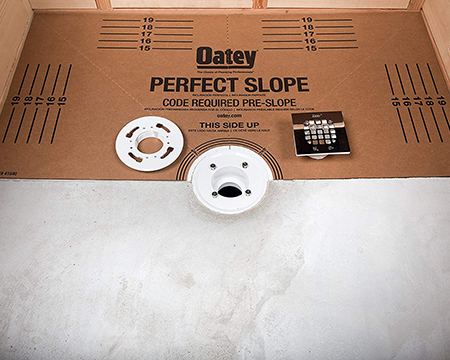Tub-to-shower conversions have become increasingly popular in recent years. With lifestyle changes and accessibility concerns, many homeowners opt to remove their bathtubs and install a shower instead.
However, this process involves several key considerations to ensure it is done correctly and affordably. This guide will cover the primary factors to consider when converting a tub to a shower, why people do it, and some products to consider for the job.
There are multiple reasons why homeowners might decide to convert their bathtub to a shower:
- Increased accessibility: A tub can be challenging and dangerous to navigate for some people, and a walk-in shower will be a more accessible solution.
- Lifestyle changes: Lifestyle changes might lead homeowners to opt for showers. For instance, older couples who no longer have young children might want to remove the bathtub in favor of an accessible shower.
- Home Value: Adding a shower to a bathroom can add value to a home if done correctly since many buyers prefer a spacious shower to a small bathtub.
- Cleanliness and maintenance: Not having to lean over a wet tub to clean it saves considerable time while reducing the risk of injury. In particular, curbless showers with a linear drain make for easier maintenance and cleaning by directing the water towards a drain that slopes in a single direction.
A linear shower drain also offers lower maintenance because it can be integrated with larger-format tiles. The latter have fewer grout joints and seams where mold, mildew, and grime can occur.
Three Factors to Consider Before Converting Your Bathtub to a Shower
When considering a tub-to-shower conversion, keep in mind these important factors:
1. Relocating drains and pipes
A significant pain point in tub-to-shower conversions is the relocation of drains, which can be both complex and costly.
It’s crucial to assess the existing locations of drains and water supply. They will have a direct impact on the feasibility and cost of the conversion. Relocating pipes can be complex and expensive, so consulting with a professional is highly recommended to determine the best approach for your situation.
A great solution to this issue is the QuickDrain ShowerLine Linear Shower Drain. This site-sizable linear drain body provides wall-to-wall coverage, allowing you to keep the existing drain pipe in place whether or not it is precisely centered. QuickDrain linear drains solve the “off-center drain” challenge because they can be customized to adapt to existing drain locations while also covering the fact that the drain is off-center.
QuickDrain’s drain trough extensions enable installers to move the linear drain body from side to side to avoid site obstructions.
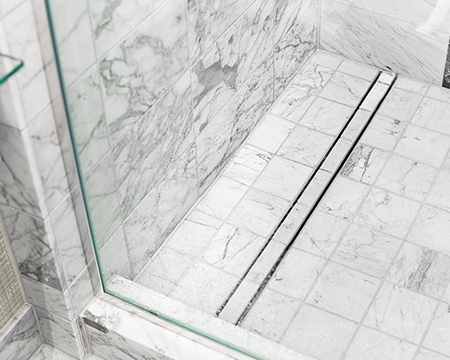
This linear drain system can be positioned against the shower wall or at other strategic points, such as the shower entrance. Multiple linear drain bodies and several outlet configurations are available, including 2-inch vertical, 2-inch side waste (90°), 1.5-inch vertical, and 1.5-inch side waste (90°).
These outlet configurations offer more flexibility in your conversion layout and can help minimize the need for extensive plumbing modifications. QuickDrain linear drains can be purchased with pre-sloped PET shower pans.
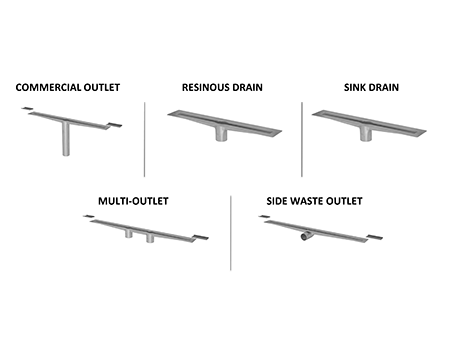
2. Bathroom layout
The layout of your bathroom plays a significant role in the design of your new shower. Maximizing the available space becomes even more critical if you have a small bathroom. Several options exist, such as installing a curbed shower, a curbless entry, a wet room, or a corner shower. Each option has advantages and considerations, so choosing the one that best suits your needs and the available space is essential.
For those seeking enhanced layout flexibility in their bathroom conversions, QuickDrain pre-sloped PET Pans offer an excellent solution. These ready-to-tile pans facilitate the installation of curbed or curbless showers and wet rooms.
QuickSlope PET Shower pans are compatible with QuickDrain shower systems and eliminate the need for a traditional mortar bed, reducing overall installation time and labor costs. Lightweight and durable, these pans are sustainably made with 100% recycled plastic as part of QuickDrain's commitment to minimize its environmental footprint.
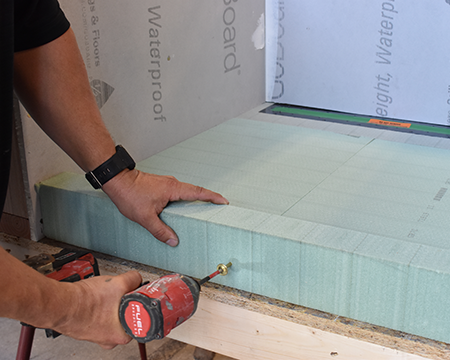
These PET pans are easy to cut and waterproof, making them a reliable choice for various bathroom sizes and designs. Each PET foam component can be easily cut and pieced together without costly customization, eliminating the time and labor to float the typical pitched concrete shower base.
Wall-to-wall linear drains, like the QuickDrain ShowerLine, offer exceptional layout flexibility, transforming how you approach your tub-to-shower conversion. Traditional shower drains are usually placed in the center of the shower floor, dictating the placement and slope of the shower pan. In contrast, QuickDrain's wall-to-wall linear drain system can be installed against the shower wall or at any strategic location within the shower space, providing a broader range of layout options.
This flexibility is not just limited to the position of the drain. It also extends to the design of the shower floor, which can be single-sloped rather than sloped from all sides towards a central point. This single-slope design simplifies installation and allows for greater freedom in tile size and pattern choices. From large format tiles to smaller, intricate mosaic designs, the options are virtually limitless with a wall-to-wall linear drain system.
3. Space
Ensuring that your bathroom has enough space to accommodate the new shower comfortably is essential. This includes considering additional features like benches or body sprays if desired. Proper planning and measurement are crucial to avoid potential issues or limitations during installation.
By carefully evaluating the existing infrastructure, considering the layout of your bathroom, and ensuring adequate space, you can make informed decisions for your tub-to-shower conversion.
Key Products to Consider for Your Tub-to-Shower Conversion
Now that consideration and reasons are covered, let’s review some products you might consider to save time and money when converting your tub to a shower.
- Oatey decorative drains offer an affordable way to give your shower a stylish look. They offer multiple finishes and designs to suit different tastes. Add functional elegance to your shower with the Oatey® Designline™ Linear Shower Drain. The linear drain length and width are engineered to achieve the best fit, form and function in a tile shower.
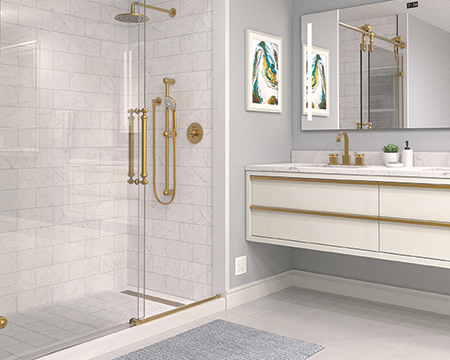
Simply change the drain height in your shower by adjusting the leveling feet. The 2-inch outlet adaptor with an O-ring attaches to standard drain outlets. The drain is compatible with both PVC and CPE waterproofing liners. With a sloped channel design, you can be sure that water consistently flows to the drain outlet. The included raising tool and removable basket allow you to lift the drain cover easily and remove debris.
- QuickDrain Linear Drains: QuickDrain ShowerLine Linear Drains are an excellent tub-to-shower conversion solution. It is a linear shower drain that offers different waste outlet orientations.
- QuickDrain WallDrain: If you want a wall-mounted shower drain that gives a modern look to your bathroom, QuickDrain WallDrain is an excellent option.
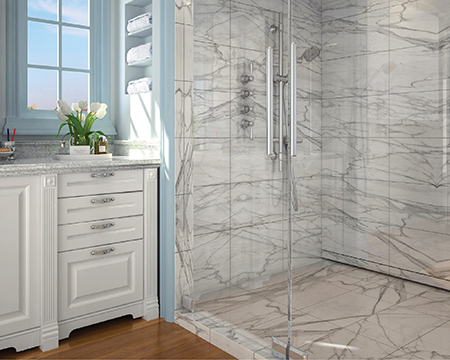
- Shower pre-slope: Lastly, when creating a sloped shower pan for proper water drainage, Oatey Perfect Slope can help make the process stress-free and efficient. It allows you to install a perfect tile shower pre-slope, requiring half the mortar and half the time.
Tub-to-shower conversions are an excellent way to upgrade your bathroom and increase your home’s value. However, before starting this process, it’s essential to consider the existing location of pipes, layout, and space.
Finally, when converting your tub to a shower, it is also important to consider products that will save time and money, such as Oatey decorative drains, QuickDrain Showerline, and Oatey Perfect Slope. With the proper considerations and products, you can convert your tub to a walk-in shower and enjoy a modern, functional, and stylish bathroom.
